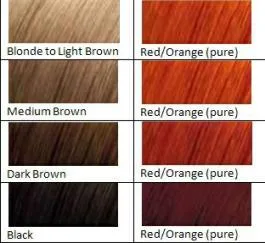The Art and Science of 20 Henna Hair Dye Colors You Will Love: Crafting Unique Hues Naturally
Henna hair dye has long been celebrated for its ability to impart rich, vibrant colors while also conditioning and strengthening the hair. Originating from the Lawsonia inermis plant, henna offers a natural alternative to synthetic dyes, making it a popular choice among those seeking chemical-free options. In this comprehensive guide, we will explore the wide spectrum of henna hair dye colors available and delve into the art of creating new shades through various mixing techniques.

The Basics of Henna Dye Hair Colors
Henna, in its purest form, produces a reddish-orange color due to the dye molecule lawsone, which binds to the keratin in hair. However, henna’s versatility extends beyond this basic hue. By mixing it with other natural ingredients like indigo, amla, and cassia, you can achieve an array of colors, from deep blacks to subtle browns and even golden blondes. Let’s explore the traditional and modern approaches to using henna for hair dyeing.
Classic Henna Dye Hair Colors
1. Red Henna: The classic red henna color is a vibrant, fiery red-orange. This shade is perfect for those looking to make a bold statement or enhance their natural red tones. The depth of red can vary based on the natural color of the hair, with lighter hair achieving a brighter red and darker hair resulting in a richer auburn.
2. Black Henna (Indigo):
While pure henna cannot produce black on its own, combining it with indigo (Indigofera tinctoria) can yield a deep, jet-black color. This two-step process involves first applying henna to create a red base, followed by an indigo application to achieve the black hue.
3. Brown Henna:
Various shades of brown can be achieved by mixing henna with different proportions of indigo and other natural ingredients. For example:
- Light Brown: A mixture of henna with a small amount of indigo can create a light brown shade.
- Medium Brown: Increasing the indigo content results in a medium brown color.
- Dark Brown: A higher concentration of indigo with henna yields a rich, dark brown.

4. Blonde and Golden Tones:
Cassia obovata, also known as neutral henna, can be used to achieve blonde and golden tones, especially on lighter hair. When mixed with a small amount of henna, cassia can impart a golden hue, while pure cassia gives a subtle, sun-kissed effect.
Creating New Henna Hair Dye Colors
Crafting unique henna hair dye colors involves understanding the interplay between henna and other natural ingredients. Here’s how you can experiment with different mixtures to achieve the desired shade:
1. Adding Indigo for Black and Brown Shades:
- Jet Black: To achieve jet black, apply henna first and then follow up with a strong indigo application. For a cooler black, use more indigo; for a warmer black, use a 50:50 mix of henna and indigo.
- Brown Shades: Adjusting the ratio of henna to indigo can produce a range of browns. For example, a 75:25 henna to indigo ratio can result in a medium brown, while a 50:50 mix yields dark brown.
2. Blending with Amla for Cool Tones:
Amla (Indian gooseberry) can cool down the warm tones of henna, making it ideal for those seeking ashier shades. Adding amla to your henna mix can also enhance the curl pattern and volume of the hair.
3. Mixing with Cassia for Golden and Blonde Hues:
- Golden Blonde: A mixture of cassia with a small amount of henna can create a beautiful golden blonde color. This works best on lighter hair shades.
- Strawberry Blonde: For a hint of red, add a small amount of henna to cassia. This creates a strawberry blonde effect, perfect for those looking to add warmth to their hair.
4. Adding Hibiscus for Purple, Burgundy and Mahogany:
Hibiscus powder can enhance the purple and blue tones in indigo, producing a deep burgundy or mahogany color. This is especially effective on darker hair, where it adds a subtle but noticeable red sheen.
5. Experimenting with Other Herbs and Ingredients:
- Chamomile: Known for its natural lightening properties, chamomile can be added to henna to create lighter, more golden tones.
- Turmeric: For a warmer, more yellowish hue, turmeric can be combined with henna. This is particularly effective for creating golden blonde shades.
- Beetroot Powder: For a richer, deeper red, beetroot powder can be added to the henna mix.
20 Henna Dye Hair Tints That Are All Natural
- Redhead
- Strawberry Blond
- Cherry Red
- Vibrant Red
- Burgundy
- Light Brown
- Medium Brown
- Dark Brown
- Mahogany
- Soft Black
- Jet Black
- Auburn (brown mixed with a small amount of natural red)
- Purple (indigo mixed with Bud Ice)
- Lavender (Indigo mixed with bud ice and boiled hibiscus leafs)
- Copper
- Light Blond
- Ash Brown
- Blond (mix light blond with ash)
- Cherry Brown
- Gold (strawberry blond using Grandpa’s Pine soap as a prep and rinse)
Practical Tips for Henna Hair Coloring
1. Strand Testing:
Always perform a strand test before applying henna to your entire head. This will help you determine the final color outcome and adjust your mix if necessary.
2. Application Techniques:
For even color distribution, apply henna paste to clean, damp hair. Use an applicator brush or gloved hands to work the dye from the roots to the ends. Leave the dye on for 45-60 minutes, depending on the desired intensity.
3. Post-Application Care:
After rinsing out the henna, be sure to shampoo 24 hours later and allow the color to fully develop. Then you can use a normal oil free conditioner. The color will continue to deepen over the next few days.
4. Maintenance:
To maintain the vibrancy of your henna color, use sulfate-free shampoos and avoid excessive heat styling and oils or leave-in products. Regular touch-ups every 4-6 weeks will keep your color fresh. Focus on the new hair growth and touch up roots as needed. Doing the entire hair will make it darker. Do the entire head as color fades over the next several months.
The Benefits of Henna Hair Dye
Henna offers numerous benefits beyond just coloring hair. It conditions the hair, making it softer and shinier. The natural properties of henna also strengthen the hair shaft, reducing breakage and promoting healthier hair growth. Additionally, henna provides a natural UV filter, protecting the hair from sun damage.
Conclusion
Henna hair dye is a versatile and natural way to color your hair, offering a wide range of shades from fiery reds to deep blacks and everything in between. By experimenting with different natural ingredients, you can create unique and personalized colors that suit your style and preferences. With its conditioning properties and long-lasting results, henna is a popular choice for those seeking a natural and sustainable alternative to synthetic hair dyes.
Whether you’re looking to cover grays, enhance your natural color, or experiment with a bold new shade, henna offers a safe and effective solution. Embrace the beauty of natural hair coloring with henna and discover the endless possibilities of creating your own custom hues.
Resources:
Resources:
What is henna hair dye?
How long does henna Last?
Buy Henna Hair Dye
Henna hair dye myths
Henna for Beards
Henna Hair Dye Ingredients
Henna Videos Doing Hair
Before and After Henna Beard Dye
Before and After Henna Hair Dye
Why use henna on your hair and beard?
Henna Dye Hair Colors
How to lighten the henna in your hair
Should you wrap your hair after applying henna hair dye?
How to apply henna hair dye tutorial